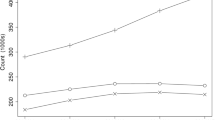Abstract
Introduction
Emergency department (ED) crowding compromises patient outcomes. Existing crowding measures are complex and difficult to use in real-time. This study evaluated readily available single flow variables as crowding measures.
Methods
Over 2 weeks in a tertiary Canadian ED, we recorded the following potential crowding measures during 168 consecutive two-hour study intervals: total ED patients (census), patients in beds, patients in waiting rooms, patients in treatment areas awaiting MD assessment; number of inpatients boarding, and ED occupancy. We also calculated four complex crowding scores—NEDOCS, EDWIN, ICMED, and a local modification of NEDOCS. We performed ROC analyses to assess the predictive validity of these measures against a reference standard of physician perception of crowding.
Results
We gathered data for 144 (63.9%) of 168 study intervals. ED census correlated strongly with crowding (AUC = 0.82, 95% CI 0.76–0.89), as did ED occupancy (AUC = 0.75, 95% CI 0.66–0.83). Their performance was similar to NEDOCS (AUC = 0.80) and to the local modification of NEDOCS (AUC = 0.83).
Conclusion
ED occupancy as a single measure has similar predictive accuracy to complex crowding scores and is easily generalizable to diverse emergency departments. Real-time tracking of this simple indicator could be used to prompt investigation and implementation of crowding interventions.
Résumé
Introduction
L'encombrement des services d'urgence (SU) compromet les résultats pour les patients. Les mesures d'encombrement existantes sont complexes et difficiles à utiliser en temps réel. Cette étude a évalué des variables de débit unique facilement disponibles comme mesures d'encombrement.
Les méthodes
Pendant deux semaines dans un service d'urgence tertiaire canadien, nous avons enregistré les mesures d'encombrement potentiel suivantes au cours de 168 intervalles d'étude consécutifs de deux heures : nombre total de patients dans le service d'urgence (recensement), patients dans les lits, patients dans les salles d'attente, patients dans les zones de traitement en attente d'une évaluation médicale ; nombre de patients hospitalisés en internat et occupation du service d'urgence. Nous avons également calculé quatre scores de surpeuplement complexes : NEDOCS, EDWIN, ICMED et une modification locale de NEDOCS. Nous avons effectué des analyses ROC pour évaluer la validité prédictive de ces mesures par rapport à une norme de référence de perception du surpeuplement par les médecins.
Résultats
Nous avons recueilli des données pour 144 (63,9 %) des 168 intervalles d'étude. Le recensement des urgences est fortement corrélé avec le surpeuplement (ASC = 0.82, IC 95 % = 0.76–0.89), tout comme l'occupation des urgences (ASC = 0.75, IC 95 % = 0.66–0.83). Leur performance était similaire à celle des NEDOCS (ASC = 0.80) et à la modification locale des NEDOCS (ASC = 0.83).
Conclusion
L'occupation des urgences en tant que mesure unique a une précision prédictive similaire aux scores complexes de surpeuplement et est facilement généralisable à divers services d'urgence. Le suivi en temps réel de ce simple indicateur pourrait être utilisé pour accélérer l'enquête et la mise en œuvre des interventions en cas de surpeuplement.
Similar content being viewed by others
References
Innes GD, Sivilotti ML, Ovens H, McLelland K, Dukelow A, Kwok E, et al. Emergency overcrowding and access block: a smaller problem than we think. CJEM. 2019;21(2):177–85. https://doi.org/10.1017/cem.2018.446.
Boyle A, Beniuk K, Higginson I, Atkinson P. Emergency department crowding: time for interventions and policy evaluations. Emerg Med Int. 2012. https://doi.org/10.1155/2012/838610.
Stang AS, Crotts J, Johnson DW, Hartling L, Guttmann A. Crowding measures associated with the quality of emergency department care: a systematic review. Acad Emerg Med. 2015;22(6):643–56. https://doi.org/10.1111/acem.12682.
Bernstein SL, Verghese V, Leung W, Lunney AT, Perez I. Development and validation of a new index to measure emergency department crowding. Acad Emerg Med. 2003;10(9):938–42. https://doi.org/10.1197/S1069-6563(03)00311-7.
Weiss SJ, Derlet R, Arndahl J, Ernst AA, Richards J, Fernández‐Frankelton M, et al. Estimating the degree of emergency department overcrowding in academic medical centers: results of the National ED Overcrowding Study (NEDOCS). Acad Emerg Med. 2004;11(1):38–50. doi:https://doi.org/10.1197/S1069-6563(03)00583-9.
Boyle A, Atkinson P, Verdejo CB, Chan E, Clouston R, Gilligan P, et al. Validation of the short form of the International Crowding Measure in Emergency Departments: an international study. Eur J Emerg Med. 2019;26(6):405–11. https://doi.org/10.1097/MEJ0000000000000579.
Nunnally JC, Bernstein IH. Psychometric Theory. 3rd ed. New York: McGraw-Hill; 1994.
Jones P, Wells S, Ameratunga S. Towards a best measure of emergency department crowding: lessons from current Australasian practice. Emerg Med Australas. 2018;30(2):214–21.
Waxman DA, Husk G, Akhtar S, Krishnamurthy C. Hourly emergency department census: a simple measure of crowding. Ann Emerg Med. 2004;44(4):S19.
McCarthy ML, Aronsky D, Jones ID, Miner JR, Band RA, Baren JM, et al. The emergency department occupancy rate: a simple measure of emergency department crowding? Ann Emerg Med. 2008;51(1):15–24.
Acknowledgements
The authors would like to acknowledge the support provided by Horizon Research Services including Denise Leblanc-Duchin for assistance in study design and Joshua Murray and George Stoica for assistance with data analysis. Additionally, the authors acknowledge Dr. Grant Innes for his feedback and suggestions to enhance the clarity of the manuscript.
Funding
This research received no specific grant from any funding agency, commercial or not-for-profit sectors.
Author information
Authors and Affiliations
Corresponding author
Ethics declarations
Conflict of Interest
None.
Supplementary Information
Below is the link to the electronic supplementary material.
Rights and permissions
About this article
Cite this article
Clouston, R., Atkinson, P., Canales, D.D. et al. Emergency department occupancy is useful as a simple real-time measure of crowding. Can J Emerg Med 24, 23–26 (2022). https://doi.org/10.1007/s43678-021-00098-8
Received:
Accepted:
Published:
Issue Date:
DOI: https://doi.org/10.1007/s43678-021-00098-8




